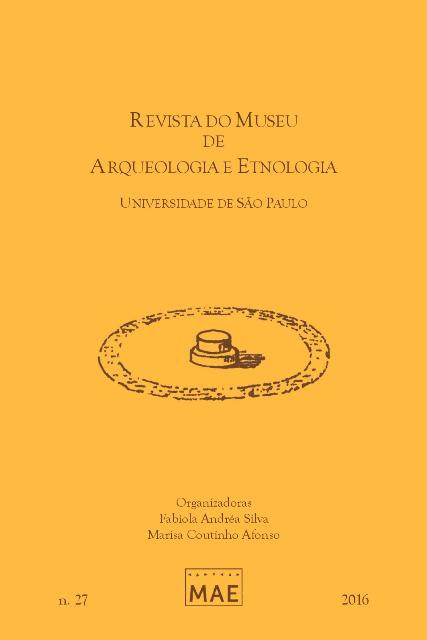Exploring the spatiality of a Itararé-Taquara site: a study case at Areia Branca 5, southeast São Paulo State
DOI:
https://doi.org/10.11606/issn.2448-1750.revmae.2016.137281Keywords:
Itararé-Taquara Tradition, Method, Archaeology, PlowzoneAbstract
The Areia Branca 5 site is related to the Itararé-Taquara Tradition, in the southeast of the State of São Paulo. It is located on a plowed land and was subjected to a method that aimed at maximizing the extraction of spatial information. Even in the context of plowed land, which could lead the site to be considered "altered" or "destroyed", it was clear that the spatiality of the site was not heavily compromised. We discuss the implications of the method used and the inadequacy of collection methods that do not recognize the potential information of sites in plowed land.
Downloads
References
Ammerman, A.J., Feldman, M.W. 1978. Replicated collection of site surfaces. American Antiquity 43(4): 734-740.
Araujo, A.G.M. 1995. Levantamento Arqueológico Da Área Alto Taquari, Estado De São Paulo, Com Ênfase Na Abordagem Dos Sítios Líticos. Dissertação de Mestrado. Universidade de São Paulo, São Paulo.
Araujo, A.G.M. 1999. As geociências e suas implicações em teoria e métodos arqueológicos. Revista do Museu de Arqueologia e Etnologia, Anais da I Reunião Internacional de Teoria Arqueológica na América do Sul. Suplemento 3: 35-45.
Araujo, A.G.M. 2001. Teoria e Método em Arqueologia Regional: Um Estudo de Caso no Alto Paranapanema, Estado de São Paulo. Tese de Doutorado. Universidade de São Paulo, São Paulo.
Araujo, A.G.M. 2002. Destruído pelo arado? Arqueologia de superfície e as armadilhas do senso comum. Revista de Arqueologia 14/15: 7-28.
Araujo, A.G.M. 2007. A tradição cerâmica Itararé-Taquara: características, área de ocor rência e algumas hipóteses sobre a expansão dos grupos Jê no sudeste do Brasil. Revista de Arqueologia 20: 09-38.
Araujo, A.G.M., Ortega, D., Schrage, T., Okumura, M., Ceccantini, G.T. 2016. A Tradição Itararé na região central do Estado de São Paulo: O Sítio Benedito Machado, Botucatu (SP) e suas possíveis relações com o Brasil Central. Cadernos do LEPAARQ 13 (25): 7-23.
Carr, C. 1984. The nature of organization of intrasite archaeological records and spatial analytic approaches to their investigation. Advances in Archaeological Method and Theory 7: 103-222.
DeBlasis, P.D. 1997. Diagnóstico do Patrimônio Arqueológico Situado no Traçado do Gasoduto Bolívia-Brasil no Estado de São Paulo. Relatório. Museu de Arqueologia e Etnologia da Universidade de São Paulo. São Paulo.
Donnelly, K.P. 1978. Simulations to determine the variance and the edge effect of total nearest-neighbor distance. In: Hodder, I. (Ed.), Simulation Studies in Archaeology, Cambridge University Press, Cambridge, 91-95.
Dunnell, R.C. 1982. Science, social science, and common sense: the agonizing dilemma of modern Archaeology. Journal of Anthropological Research 38: 1-25.
Greig-Smith, P. 1983. Quantitative Plant Ecology. Blackwell.
Hodder, C., Okell, E. 1978. A new method for assessing the association between distributions of points in archaeology. In: Hodder, I. (Ed.), Simulation Studies in Archaeology. Cambridge University Press, Cambridge, 97-107.
Hodder, I., Orton, C. 1976. Spatial Analysis in Archaeology. Cambridge University Press.
Jermann, J. 1981. Archaeology, Space and Sampling: Methods and Techniques in the Study of Pattern in Past Cultural Activity. Ph.D. Dissertation. University of Washington, Seattle.
Kintigh, K.W. 1990. Intrasite spatial analysis: a commentary on major methods. In: Voorrips, A. (Ed.). Mathematics and Information Sciences in Archaeology: A Flexible Framework. Holos, Bonn: 165-200.
Lewarch, D.E., O'Brien, M.J. 1981. Effect of short term tillage on aggregate provenance surface patterns. In: O'Brien, M.J., Lewarch, D.E. (Ed.). Plowzone Archaeology: Contributions to Theory and Technique. Publications in Anthropology 27. Vanderbilt University: 7-49.
Odell, G.H., Cowan, F. 1987. Estimating tillage effects on artifact distribution. American Antiquity 52: 456-484.
Ord, J.K. 1972. Families of Frequency Distributions. Griffin’s Statistical Monographs and Courses. Griffin, London.
Peterson, L.D. 1982. The application of controlled surface collection methods in archaeological survey and assessment. The Minnesota Archaeologist 41(2): 47-52.
Robrahn, E.M. 1998. A Ocupação Pré-Colonial do Vale do Ribeira de Iguape, SP: Os Grupos Ceramistas do Médio Curso. Dissertação de Mestrado. Universidade de São Paulo, São Paulo.
Rogers, A. 1974. Statistical Analysis of Spatial Dispersion: The Quadrat Method. Pion Limited, London.
Shennan, S. 1997. Quantifying Archaeology. University of Iowa Press, Iowa City.
Shott, M.J. 1995. Reliability of archaeological records on cultivated surfaces: a Michigan case study. Journal of Field Archaeology 22: 475-490.
Wandsnider, L. 1996.Describing and Comparing Archaeological Spatial Structures. Journal of Archaeological Method and Theory 3(4): 319-384
Whallon, R. 1974. Spatial analysis of occupation floors II: the application of nearest-neighbor analysis. American Antiquity 39(1): 16-34.
Zubrow, E.B., Harbaugh, J.W. 1978. Archaeological prospecting: kriging and simulation. In: Hodder, I. (Ed.). Simulation Studies in Archaeology. Cambridge University Press, 109-122.
Downloads
Published
Issue
Section
License
Copyright (c) 2016 Astolfo G.M. Araújo

This work is licensed under a Creative Commons Attribution-NonCommercial-NoDerivatives 4.0 International License.













